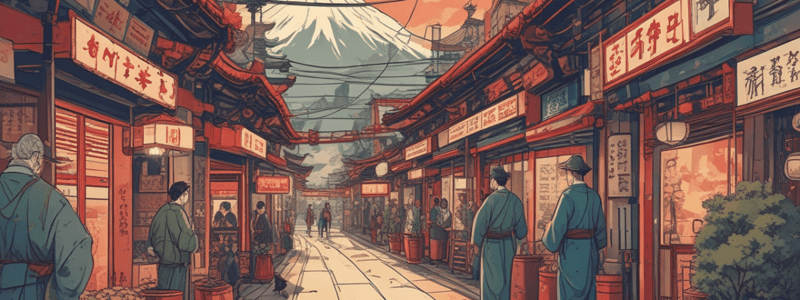Podcast
Questions and Answers
What was the main goal of the concept book titled Wonder Nippon! released by the Japanese Ministry of Economy, Trade, and Industry in 2017?
What was the main goal of the concept book titled Wonder Nippon! released by the Japanese Ministry of Economy, Trade, and Industry in 2017?
- To promote Japan's industrialization
- To convey Japan's unique sensibilities and values to the rest of the world (correct)
- To showcase Japan's modern art
- To highlight Japan's military power
What is often featured in tourist pamphlets, media productions, and popular discourse in Japan and abroad?
What is often featured in tourist pamphlets, media productions, and popular discourse in Japan and abroad?
- Japan's military history
- The attractiveness of Japanese crafts (correct)
- Japanese cuisine
- Japan's industrial progress
When did the Japanese government start promoting craft specialists to produce works for international exhibitions?
When did the Japanese government start promoting craft specialists to produce works for international exhibitions?
- During the post-war era
- During World War II
- During the Meiji period (correct)
- During the Edo period
Why did European artists turn their attention to Japan in the late 19th century?
Why did European artists turn their attention to Japan in the late 19th century?
What contributed to Japan's cultural diplomacy in the post-war era?
What contributed to Japan's cultural diplomacy in the post-war era?
What was the outcome of the Japanese government's promotion of crafts in the late 19th century?
What was the outcome of the Japanese government's promotion of crafts in the late 19th century?
What did European artists see in Japan's crafts?
What did European artists see in Japan's crafts?
What attracted Westerners to Japan from the 1960s?
What attracted Westerners to Japan from the 1960s?
What is a characteristic that Japanese ceramics share with other East Asian ceramics?
What is a characteristic that Japanese ceramics share with other East Asian ceramics?
What was introduced to Japan from China and Korea in the 5th and 16th centuries?
What was introduced to Japan from China and Korea in the 5th and 16th centuries?
What was the result of the ashes from the firewood melting on the surface of ceramic pieces?
What was the result of the ashes from the firewood melting on the surface of ceramic pieces?
What coincided with the interest in tea ceramics and the tradition of the six old kilns in the West?
What coincided with the interest in tea ceramics and the tradition of the six old kilns in the West?
What stimulated a mindset of freedom and experimentation in the West?
What stimulated a mindset of freedom and experimentation in the West?
Why did some foreign apprentices find their experience in Japan disappointing?
Why did some foreign apprentices find their experience in Japan disappointing?
Why do some potters prefer to work with ceramics in Japan?
Why do some potters prefer to work with ceramics in Japan?
What did many foreigners who came to practice ceramics in Japan eventually do?
What did many foreigners who came to practice ceramics in Japan eventually do?
What is a common challenge faced by potters in the United States?
What is a common challenge faced by potters in the United States?
What is a type of knowledge that exists in the body but is often hard to put into words?
What is a type of knowledge that exists in the body but is often hard to put into words?
How many hours of practice and repetition are required to master a craft skill, according to the popular rule?
How many hours of practice and repetition are required to master a craft skill, according to the popular rule?
How do potters in Japan connect with their natural surroundings?
How do potters in Japan connect with their natural surroundings?
What is valued highly in Western art education?
What is valued highly in Western art education?
What was a challenge faced by female foreign apprentices in Japan?
What was a challenge faced by female foreign apprentices in Japan?
Why do many potters in Germany call themselves designers or artists?
Why do many potters in Germany call themselves designers or artists?
What is a characteristic of the communities that many potters have established in Japan?
What is a characteristic of the communities that many potters have established in Japan?
What is a benefit of working with ceramics in Japan, especially before the spread of the internet?
What is a benefit of working with ceramics in Japan, especially before the spread of the internet?
How do potters in Japan approach their work in relation to the materials they use?
How do potters in Japan approach their work in relation to the materials they use?
What is a similarity between potters in Japan and people who grow and prepare their own food?
What is a similarity between potters in Japan and people who grow and prepare their own food?
Why do many ceramicists in Europe and the USA resort to ready-made materials from industry?
Why do many ceramicists in Europe and the USA resort to ready-made materials from industry?
What is the traditional Western concept of art focused on?
What is the traditional Western concept of art focused on?
In Japan, what is the relationship between purpose, beauty, and everyday acts?
In Japan, what is the relationship between purpose, beauty, and everyday acts?
What did interviewees stress as important in their experiences of well-being?
What did interviewees stress as important in their experiences of well-being?
What did interviewees find in Japan that contributed to their practices?
What did interviewees find in Japan that contributed to their practices?
What concept do interviewees' identities and worldviews invoke?
What concept do interviewees' identities and worldviews invoke?
What do interviewees' narrative accounts show?
What do interviewees' narrative accounts show?
What can engagements with historical techniques, natural materials, and local communities help envision?
What can engagements with historical techniques, natural materials, and local communities help envision?
What is the relationship between the concept of planetarity and cosmopolitanism?
What is the relationship between the concept of planetarity and cosmopolitanism?
Flashcards are hidden until you start studying
Study Notes
Japan's Craft Industry
- In 2017, the Japanese Ministry of Economy, Trade, and Industry released a concept book titled Wonder Nippon! to promote Japan's unique cultural values and sensibilities to the world.
- The booklet highlights simplicity, anonymity, and harmony with nature as core values that have shaped Japan's domestic craft production.
Craft and Japanese Identity
- Japan has promoted its crafts as a symbol of Japanese culture and identity, particularly through government promotional materials, tourist pamphlets, and media productions.
- The idea of Japan as a paradise of craft has been officially promoted since the Meiji period, when the Japanese government sponsored craft specialists to produce works for international exhibitions.
Cultural Diplomacy and Crafts
- Crafts have played a significant role in Japan's cultural diplomacy, with craftspeople traveling the world to give talks and demonstrations, contributing to shifting Japan's military image after World War II.
- This led to Westerners coming to Japan to learn crafts, particularly ceramics, from the 1960s.
Japanese Ceramics
- Japanese ceramics have been strongly influenced by East Asian ceramic traditions, including the use of high-temperature wood-fueled kilns introduced via China and Korea.
- This technique allows for the production of more resistant objects and creates unique aesthetics characterized by unpredictable color patterns and textures.
Zen Boom and Countercultural Movements
- The "Zen boom" in the West, starting in the 1950s, reflected a growing interest in Eastern religions and practices, leading to increased interest in Japanese crafts.
- Countercultural movements, such as the hippie movement, encouraged young Westerners to travel to Japan in search of alternative experiences and practices.
Westerners in Japan's Craft Industry
- In the post-war era, Japanese potters started accepting foreign apprentices, leading to a mix of positive and negative experiences for the foreigners involved.
- Many Westerners came to Japan to learn ceramics, and some eventually settled in rural communities, building their own studios, kilns, and practicing ceramics as a way of life.
Challenges and Opportunities
- Westerners faced challenges in Japan's craft industry, including language barriers, cultural differences, and lack of direct verbal instruction from masters.
- However, they also found opportunities to learn from Japan's rich craft traditions, connect with local communities, and engage in meaningful interactions with materials and nature.
Craft as a Way of Life
- Many interviewees emphasized the importance of craft as a way of life, allowing them to explore connections with people, objects, traditions, materials, and nature.
- They highlighted the value of beauty in everyday, sensory dimensions, and the importance of self-fulfilling and autonomous work.
Alternative Futures
- The attraction to Japanese ceramics extends beyond an interest in Japan's cultural values, invoking universal aspirations and a search for interdependent and interconnected human values.
- This approach can help envision alternative futures in an age marked by environmental degradation and cultural, national, and political divisions.
Studying That Suits You
Use AI to generate personalized quizzes and flashcards to suit your learning preferences.




